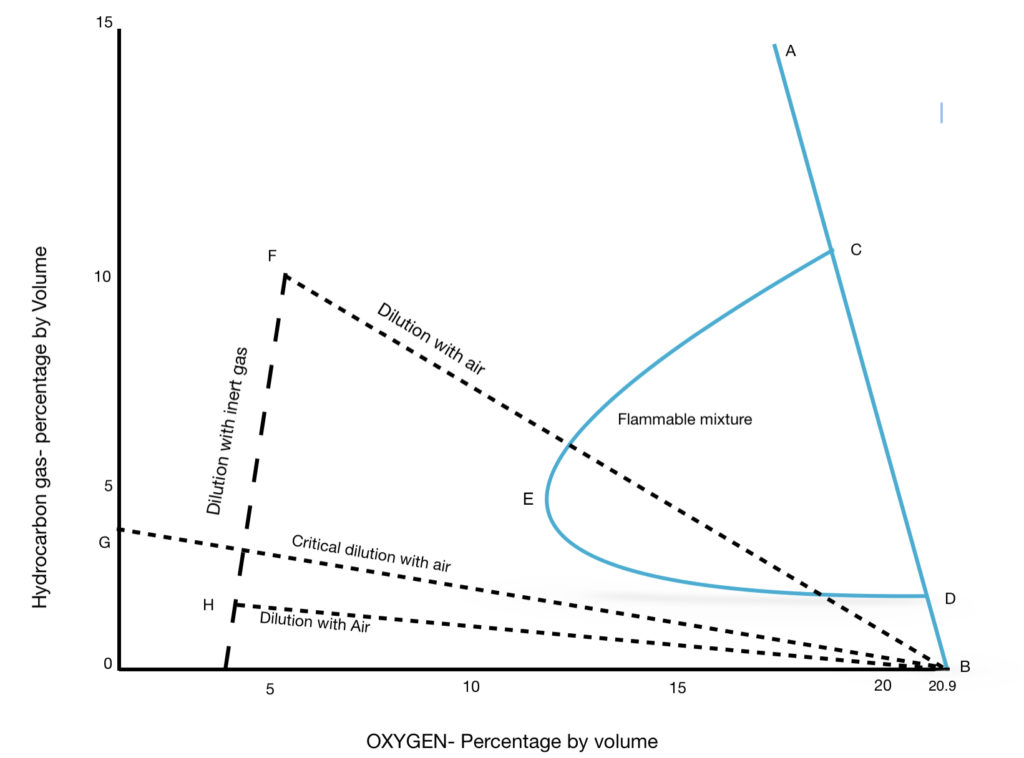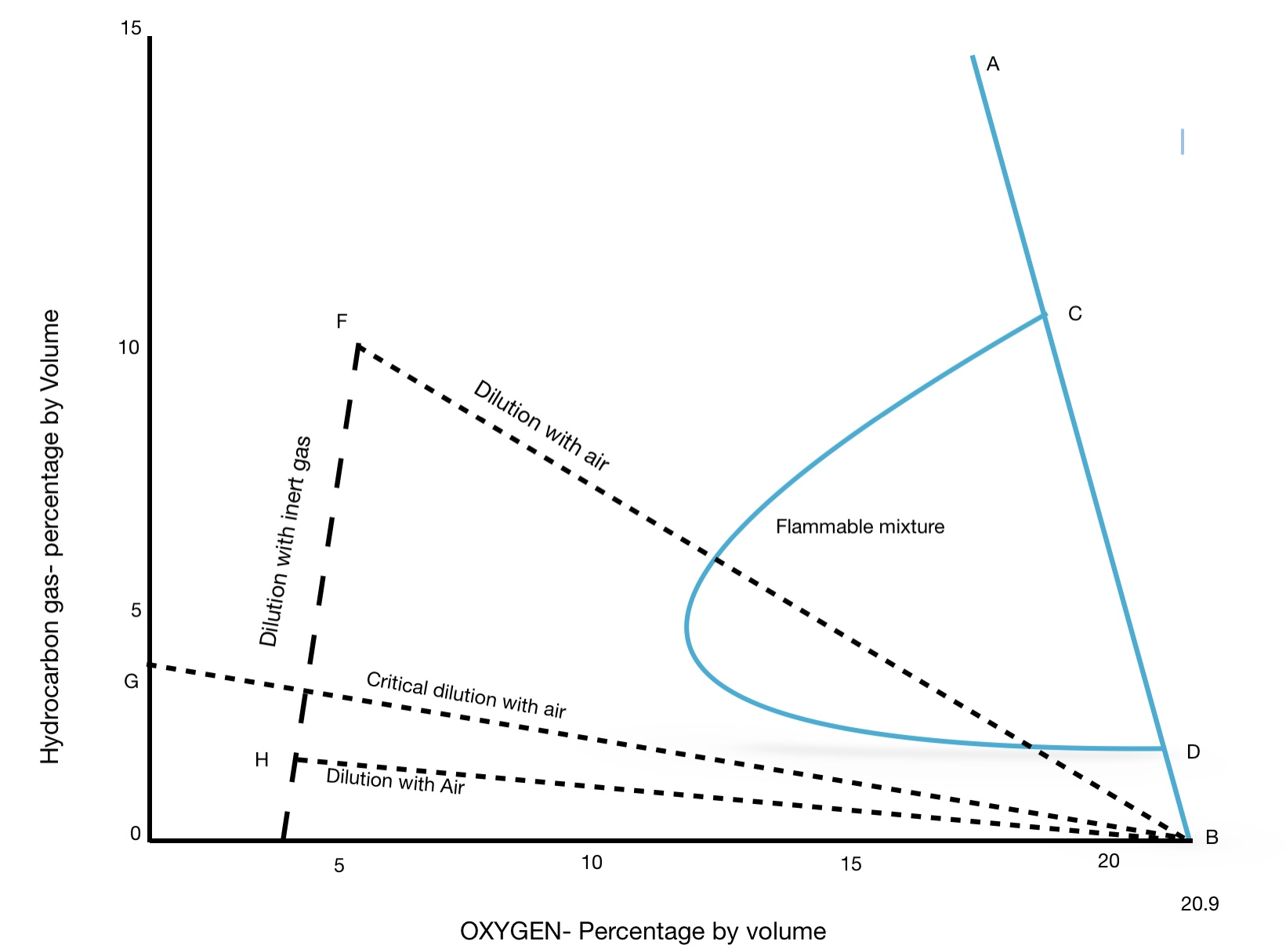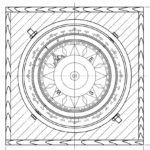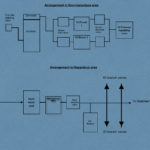The Flammability diagram
Most of us who have been sailing onboard must have read and come across the flammability diagram hundreds of times.
What we see is pretty simple, and we can draw it very easily.
But, to be honest sometimes there are a few things. About which when we study and research in detail then we come to know that there was a lot of it we missed out.
Like, we already know about the flammability diagram. How It is being used onboard tanker vessels. And used in order to verify that we have reduced the tank atmosphere at so safe levels that it is safe for fresh air entry and the space can be entered without any risk of explosion.
After reading this article, you will be easily able to answer questions, like;
- How to read the flammability diagram?
- How to understand the flammability diagram?
- and many other questions related to the topic.
So lets see why and how is it being used onboard ships.
But in order to understand the flammability diagram, first we need to understand the fire triangle.
TABLE OF CONTENTS
THE FIRE TRIANGLE
The fire triangle shows us that there are three components required for a fire to take place.
The three components are
⁃ The fuel
⁃ Heat &
⁃ Oxygen
So what we know is that, for any fire to take place, all three of these components should be present.
As we know that the petroleum products generate vapours. The vapours are really very rich in hydrocarbons.
And hydrocarbons act as very good fuel for the fire to take place.
Lets say for an example onboard, that we are loading the cargo inside one cargo tank.
Just for an assumption, just say that this tank’s atmosphere contains natural composition of air. Which means It has 20.9% of oxygen and remaining other gases.
Now as the cargo containing hydrocarbon is loaded inside it. Still the fire triangle is not complete and there is no risk of fire inside the tank.
So let me tell you that, even the oil cargoes, when flow at high rates generate static charges. These static charges have tendency to generate spark.
Once the spark is generated inside the cargo tank, and we already have the oxygen and the fuel inside the tank. There are pretty much chances that an explosion might take place.
So in order to avoid that, and for the sake of safety of the ship and the personnel onboard, There is inert gas system onboard oil tankers.
Though the inert gas system can be replaced by nitrogen onboard chemical tankers.
But the purpose still remains the same.
The purpose of the inert gas is most important onboard oil tankers and we are going to discuss next.
INERT GAS
Inert gas is a composition of inert gases or flue gases which are inert in themselves and when inserted inside a space they will make the atmosphere of that space inert.
Inert atmosphere means the space now does not have enough oxygen to support combustion.
In the inerted space, even if you try to light a matchstick or any other thing manually, you will not be able to do it.
So that is the whole purpose of inert gas, that it will assist to make the atmosphere inert and thus inert gas can also used in emergency for firefighting onboard.
Also read: Deck seal- Types, purpose and construction
Now lets come back to the flammability diagram thing.
Till now what we know is that at any place three components are needed for the fire to take place. And we already have the hydrocarbon(fuel) and the source of spark (heat) inside the cargo tank.
So now only thing we can do is either we can remove the hydrocarbons(fuel) or remove the oxygen(air) from the tank.
Do you thing that it is possible to remove the hydrocarbons from the cargo tank which already contains so much of cargo.
We can agree that once the tank is empty, we can remove the hydrocarbons by some means.
So what can we do to the tank atmosphere that the tank gets safe even if it contains hydrocarbons, source of spark and oxygen.
Actually we can reduce the amount of oxygen inside the cargo tank by the introduction of inert gas inside it.
Once the inert gas is inserted inside the cargo tank, the inert gas, as discussed earlier will make the tank atmosphere inert and safe for the cargo carriage.
That was right, that inert gas will make the cargo tank atmosphere safe.
But how will we know about how much inert gas is to be introduced inside the tank, or how much oxygen content should be there inside it, in order to call the tank safe for the cargo carriage.
So for that we are provided with the flammability diagram onboard oil tankers.
The diagram shows us the property of the crude oil, products and other petroleum products.
So Let’s discuss the diagram and its key features.
THE FLAMMABILITY DIAGRAM
So the diagram is pretty simple.
It clearly shows us the amount of pain one has to go through in order to get it done.
So now lets see about what is to be done inside the cargo tanks in order to achieve the safe atmosphere.
The atmosphere where the oxygen, the hydrocarbons and the static electricity. All 3 can live in harmony without causing discomfort to each other or the vessel or to the vessel.

In the above diagram, just look at the point “B”. This is the point where the tank atmosphere is having oxygen at 20.9%.
Now we add the cargo inside the cargo tank. Thus now the amount of oxygen reduces as soon the hydrocarbons are added to it.
As the amount of hydrocarbons increase, amount of oxygen inside the tank reduces. The diagram thus shows the slope of line AB.
Where the oxygen reduces from level B to level A, While the amount of hydrocarbons increases from zero to around 15% by volume.
So far so good. Looks pretty good until now.
Now as we can see in the figure above, there are two more points in the line AB.
The points are point C and D.
While point C is called the upper flammable limit(LFL) or the upper explosive limit of the cargo, Point D is called the lower flammable or the lower explosive limit of the cargo.
The upper flammable limit(UFL) is the limit of hydrocarbon inside the tank, above which there is very little oxygen content inside the space to support combustion.
While on the other hand, the lower explosive limit is the limit of hydrocarbon, below which there is insufficient hydrocarbons inside the space to support combustion.
So once we have the the LFL and the UFL of the cargo, we know that it is dangerous for us, if the air gas mixture passes between the upper and the lower flammable limit called the flammable range.
Till now we know that if the hydrocarbon concentration lies outside the flammable limits, it is safe.
So what we can do is by introducing the inert gas we lower the value of upper flammable limit, and increase the amount of lower flammable limit.
By increasing the LFL and reducing the UFL the flammable range is reduced.
While any point which lies on the left side of the line AB, represents the hydrocarbon gas/ air/ inert gas mixture.
So once we start adding the inert gas on line AB, addition of inert gas will reduce the upper flammable limit and increase the lower flammable limit, meeting at the point E.
Thus the area enclosed by CED lies contains the flammable mixture.
So we know that if the hydrocarbon & air mixture inside the tank lies within the flammable mixture area, then only it is capable of burning.
If it lies outside the flammable mixture then the mixture is unable to burn.
We know now about what is safe and what is unsafe atmosphere for the tank, and how can we reduce the flammable range.
The point E lies at around 11% of oxygen content. At this level, no mixture can burn. Thus making the tank atmosphere most safe.
So IMO has specified a value of oxygen content of 8% inside the cargo tank.
It means at no time, the oxygen content inside the tank must be more than 10% by volume.
Which provides a marking of safety beyond the earlier mentioned value of 11% volume of oxygen.
Now lets come to point F on the flammability diagram. Point F is where we have oxygen around 4 to 5% and the hydrocarbon content is around 11% by volume inside the cargo tank.
This is the case normally when the cargo has been discharged, but the hydrocarbon content is still there inside the tank.
At this case if we start putting fresh air inside the cargo tank, then we can see by the diagram itself that the tank will have the tendency to reach at the oxygen level of 20.9%.
So the path of dilution with air will pass through the flammable mixture causing concern and making it prone to explosion.
That’s why even if we have to make a man entry inside the cargo tank, we never put the fresh air inside the cargo tank directly. As it will get dangerous.
Now what we do is we will put more inert gas inside the cargo tank, until it reaches point H.
So once the hydrocarbon levels inside the tank are at point H, we dilute it with fresh air. Now what we see is that it passes well clear of the flammable mixture range.
While there is one more point as we can see in the diagram. That is point G, which marks the critical dilution with air path.
Which means that if the hydrocarbon level inside the cargo tank is at point G, it will pass just below the flammable range.
So we can say that anything above the Line GB will lie within the flammable range, while anything below it will be clear of the flammable range and thus it will be safe for entry.



Pingback: Inert gas system and it’s requirements - BloggingSailor